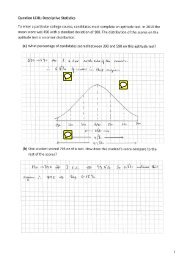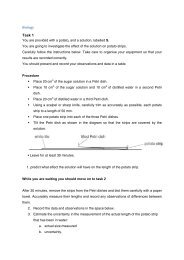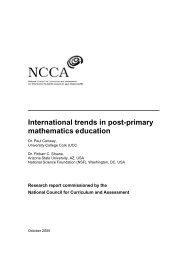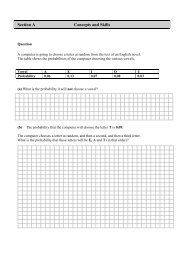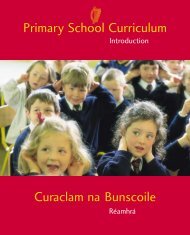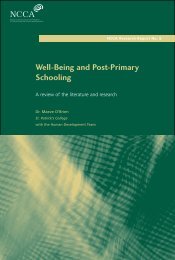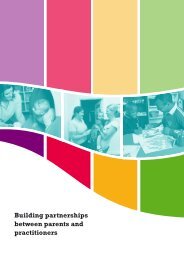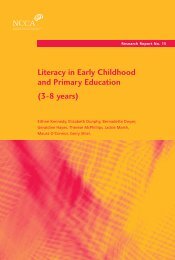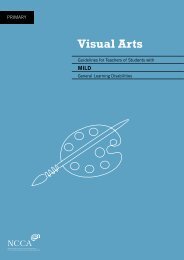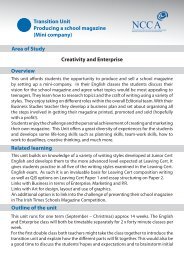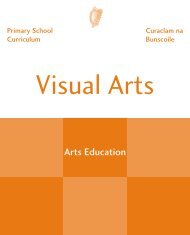Up and Away - National Council for Curriculum and Assessment
Up and Away - National Council for Curriculum and Assessment
Up and Away - National Council for Curriculum and Assessment
Create successful ePaper yourself
Turn your PDF publications into a flip-book with our unique Google optimized e-Paper software.
Class organisation<br />
Whole class.<br />
Individual. Pairs.<br />
Theme<br />
Use with any of the Units of<br />
Work of the primary<br />
curriculum.<br />
Aims<br />
Develop speaking skills.<br />
Learn new vocabulary in<br />
known contexts.<br />
Develop literacy skills based on<br />
pupils’ own language.<br />
Materials/preparation<br />
To focus on full sentences,<br />
make multiple copies of page<br />
234 to A3 size.<br />
Make multiple copies of page<br />
235 to focus on word sequence<br />
in sentences.<br />
Scissors.<br />
Notes<br />
It may be necessary to<br />
re<strong>for</strong>mulate what pupils say,<br />
helping with structure <strong>and</strong><br />
supplying vocabulary.<br />
Asking pupils to cut up the<br />
sentences into individual words<br />
encourages them to think<br />
about spacing between words.<br />
Time<br />
The time taken will vary<br />
according to:<br />
The ability of the pupils.<br />
The amount of language<br />
that is put into writing.<br />
The number of activities<br />
undertaken.<br />
Ideally spend 5-20 minutes on<br />
any one activity.<br />
Section 6 Literacy development <strong>for</strong> older pupils<br />
Using pupils’ own language<br />
Focus Time<br />
See ‘Notes’ below.<br />
Type of activity<br />
Varied.<br />
Method<br />
1. Approaches <strong>for</strong> generating spoken language<br />
Provide pupils with a focus <strong>for</strong> talking by:<br />
Using photographs <strong>and</strong> clip art of places, people, objects,<br />
situations, etc. that are familiar to the class.<br />
Using pictures from textbooks.<br />
Using a picture which pupils have drawn <strong>and</strong> invite them to<br />
describe or tell a story about it.<br />
Using a picture story.<br />
Holding a session on ‘My news’.<br />
2. Using oral language <strong>for</strong> practice activities<br />
Write sentences produced by pupils on to strips of paper, one<br />
sentence per strip – see page 234.<br />
3. Developing reading <strong>and</strong> writing skills<br />
After the pupils have read through the sentences a number of<br />
times <strong>and</strong> are familiar with the content, use the following<br />
activities. Pupils work together to manipulate the strips of paper.<br />
A. Sequencing (whole text)<br />
i. Mix up the strips of paper (i.e. the sentences).<br />
ii. Pupils work together to put the sentences in order. Start with<br />
two or three sentences <strong>and</strong> build up until the whole text is being<br />
worked on.<br />
N.B. Use this activity only if the pupils’ language has a logical<br />
sequence, such as with a story.<br />
B. Sequencing (sentences)<br />
i. Take one of the strips of paper (i.e. one sentence) <strong>and</strong> cut it into<br />
individual words.<br />
ii. Pupils sequence the words to remake the sentence.<br />
iii. Repeat with the other sentences.<br />
C. Rewriting<br />
i. Start with the first sentence of the text. Cut the strip into<br />
individual words <strong>and</strong> place them in the wrong order.<br />
ii. Pupils remake the correct sentence.<br />
iii. They then write out the sentence (use Worksheet F on page<br />
209). Repeat with the other sentences to complete the full text.<br />
Continued on next page.<br />
229



